As Germany's largest island, Rügen offers a blend of natural beauty and historic charm that makes it one of the country's most popular vacation destinations.
The island's distinctive white chalk cliffs rise dramatically from the Baltic Sea, creating landscapes that inspired the Romantic painter Caspar David Friedrich.
The island's appeal lies in its diversity. Miles of unspoilt sandy beaches alternate with ancient beech forests, while traditional seaside resorts showcase classic German resort architecture from the late 19th century.
The contrast between bustling tourist towns and tranquil fishing villages offers opportunities for both active holidays and peaceful retreats.
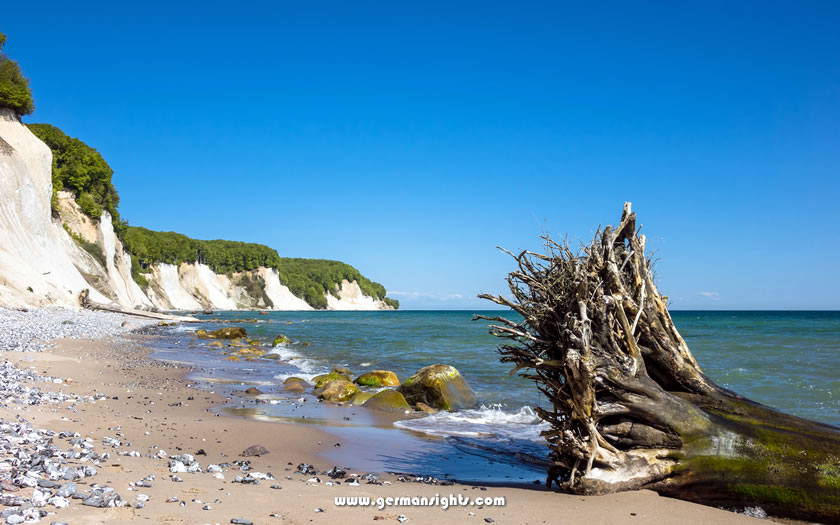
White cliffs on Rügen island
Rügen's geography creates unique microclimates that support rare plant species and provide habitats for diverse wildlife, particularly migratory cranes.
The island receives more annual sunshine than most places in Germany, making it a popular destination from spring to autumn. Winter brings its own charm, with fewer tourists and moody coastal landscapes.
Local restaurants serve fresh Baltic fish alongside international cuisine and traditional smokehouses still operate in the fishing villages. This mix of old and new, natural and cultural attractions makes Rügen a destination for everyone from outdoor enthusiasts to history buffs.
Rügen is located in north-eastern Germany in the Baltic Sea off the Pomeranian coast of Mecklenburg-Western Pomerania.
The island is linked to Stralsund on the mainland by the Rügen Bridge and the Rügen Causeway. It covers 926 square kilometres (357 square miles), and its distinctive shape is characterised by several peninsulas that extend into the Baltic Sea.
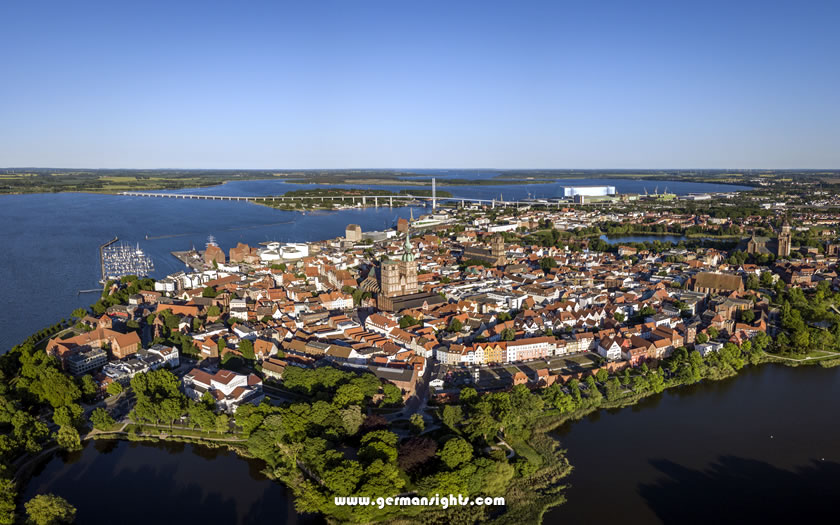
Aerial view of Stralsund and the bridge to Rügen island
Rügen marks the north-eastern tip of Germany, closer to Sweden and Denmark than to Berlin. This location has historically made it a strategic point for trade and military operations in the Baltic region.
The island's location also influences its climate. The Baltic Sea moderates temperatures, creating milder winters and cooler summers than on the mainland.
The eastern side tends to receive more sunshine than the western coast, influencing both the tourism patterns and agricultural activities.
The nearby cities of Rostock and Lübeck both have international airports, although the choice of international destinations is limited.
Distance to Rostock Airport: 143km
Distance to Lübeck Airport: 234km
Distance to
Hamburg Airport: 306km
Distance to Berlin Brandenburg Airport: 332km
Distance to Copenhagen Airport: 185km (includes ferry and international transit through Sweden)
Hamburg airport and Berlin Brandenburg airport are options with plenty of European and long-haul destinations and international carriers. Transport from both is convenient by both road and rail services.
Copenhagen is another international airport within reach, although routes either through Denmark (via Rostock) or both Denmark and Sweden (direct to Stralsund) both involve ferry journeys.
Rügen island is connected by fast InterCity services from major cities around Germany, such as Berlin, Frankfurt and Hamburg. The InterCity services call at the stations at Bergen auf Rügen and Binz.
Regional services from Stralsund operate regularly to a number of towns on Rügen island, including the major coastal resorts of Binz and Sassnitz.
A steam train service, known as 'Rasender Roland', connects a number of small towns to the beach resorts of Binz, Sellin and Göhren.
Stralsund is linked to the major cities by the A20 motorway, which runs east-west along the Baltic coast. The B96 road runs from Stralsund onto the island and then heads in a northerly direction to Sassnitz, with a number of smaller roads branching off it to different towns and villages on the island.
There are a number of small ferries which run between the German mainland and the island of Rügen, although the most popular routes onto the island are still by road or rail.
The island of Hiddensee can be reach by passenger ferry from posts on the western coast of Rügen island, such as Schaprode and Wiek.
The grand architecture and seaside promenades of Rügen's coastal towns tell the story of German beach tourism.
Each resort developed during the Baltic spa boom of the 19th century, when aristocrats and artists flocked to the island's shores.
Each destination offers a different perspective on island life, from the central hub of Bergen to the elegant villas of Binz and the working port of Sassnitz.
The island's largest town and administrative centre, located in the centre of Rügen. Known for its historic old town, St Marien church and the Ernst-Moritz-Arndt tower with panoramic views of the island. It is not located directly on the coast, but its central location and good transport connections make it an excellent starting point for exploring the entire island.
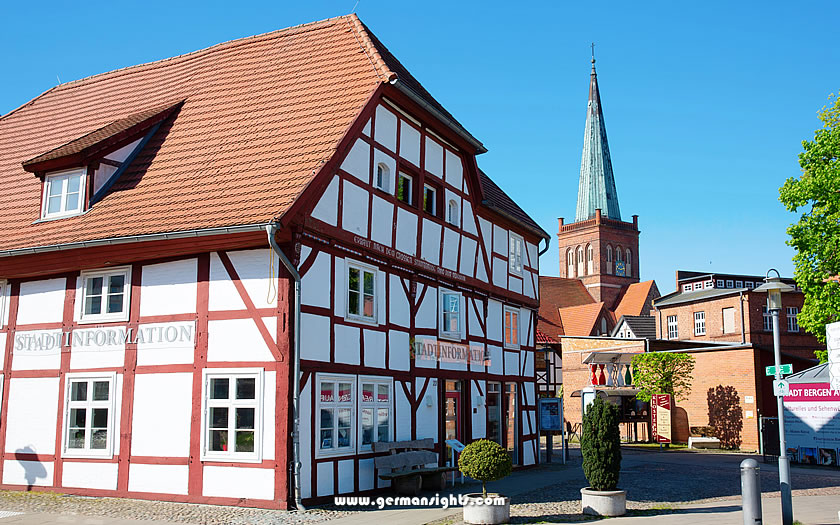
Bergen am Rügen on Rügen island
The most popular seaside resort on the island of Rügen, famous for its elegant 19th-century spa architecture and impressive 5.5km of sandy beach. The town has a beautiful promenade lined with classic white villas, numerous restaurants and the iconic pier. Nearby is the controversial but historically significant Prora complex.
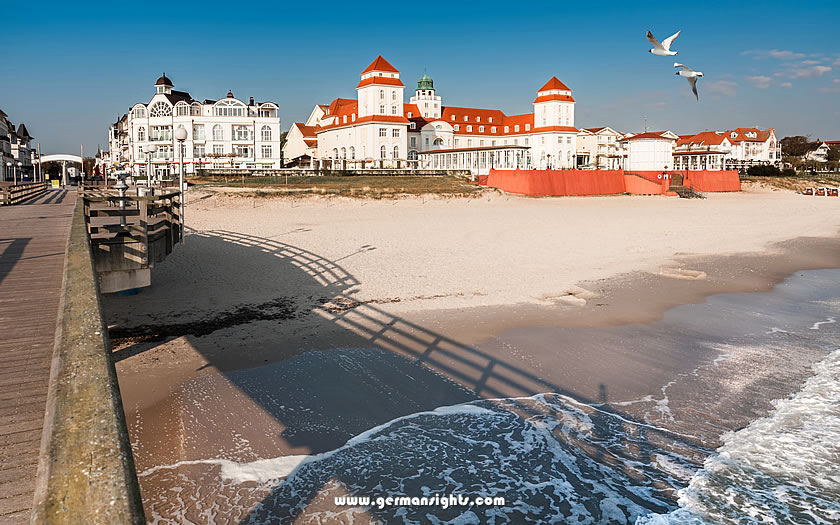
View of the beach resort of Binz on Rügen
Find out more about Binz beach resort
A picturesque fishing town and ferry port on the north-east coast, famous for its old town harbour and proximity to the famous chalk cliffs. Serves as a gateway to the Jasmund National Park and its famous Königsstuhl.
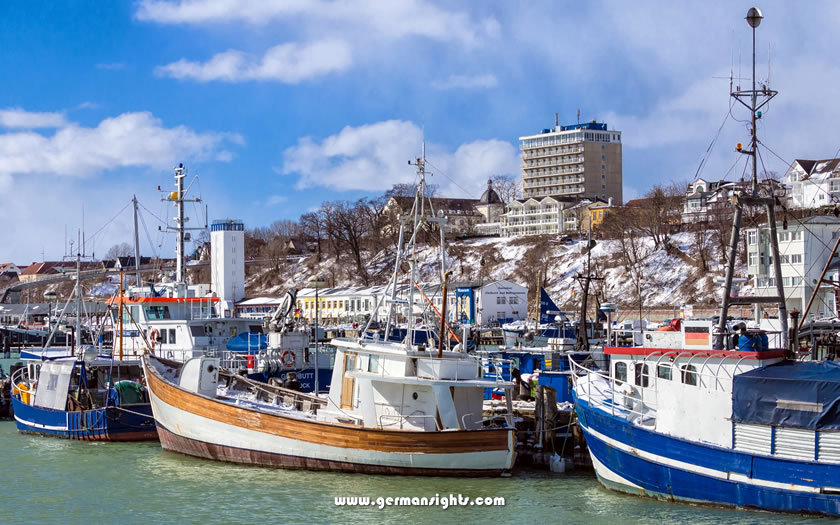
The fishing port of Sassnitz on Rügen
Another elegant seaside resort, characterised by its magnificent pier with its iconic white diving bell structure. Features beautiful Belle Epoque architecture, a stunning beach promenade and well-preserved traditional resort architecture. Popular for its family-friendly atmosphere and unspoilt beaches.
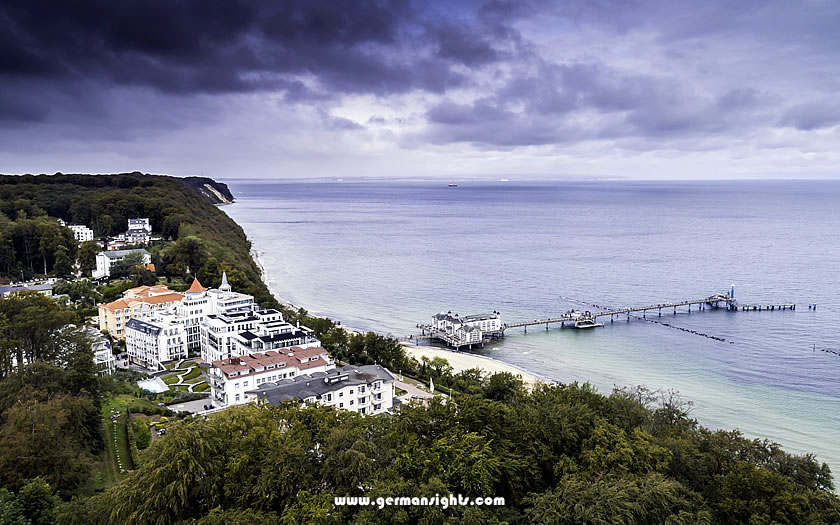
View over the beach resort of Sellin on Rügen island
Known as the "White Town" because of its classical architecture, all painted in white. The town was planned as a residential town in the early 19th century and features a circular plaza (Circus), the Putbus Palace Park and a narrow-gauge railway station for the famous "Racing Roland" steam train.

Park and war memorial in Putbus
If you know when you are planning to go but haven't decided on accommodation, then use the map below to get an idea of which properties are available and to compare prices during the period you wish to travel.
Enter your proposed dates and use the '+' to zoom in on a location and reveal more properties. Click on the price above a property to see more information.
(Please note that this selection will also include some guesthouses, pensions and self-catering apartments for those who are interested in that form of accommodation!)
Alternatively, if you would like a list of properties available on your proposed dates of travel, use the search box below to find accommodation:
Rügen's history stretches back thousands of years, with archaeological evidence of human settlement dating back to the Stone Age.
The island rose to prominence in the Middle Ages, when the Slavic Rani tribe established a powerful presence centered around the temple fortress of Arkona. This pagan fortress, dedicated to the four-headed god Svantevit, dominated the Baltic region until it was conquered by Danish forces in 1168.
Rügen was ruled by various powers in the following centuries. After the Danish period, the island became part of the Duchy of Pomerania until 1325.
Following the Thirty Years' War, Rügen was under Swedish control from 1648 to 1815, with lasting influences still visible in local architecture and place names. This period ended when the Congress of Vienna transferred the island to Prussian rule, integrating it into what would later become Germany.
The 19th century brought significant changes to Rügen as it developed into a fashionable resort destination. The German Romantic movement helped popularize the island's natural beauty, particularly through Caspar David Friedrich's paintings of the chalk cliffs.
Wilhelm Malte I, Prince of Putbus, played a crucial role in the development of the island's first seaside resort at Putbus in 1816, setting the model for later resorts such as Binz and Sellin.
The 20th century brought both dark and lighter chapters to Rügen's history.
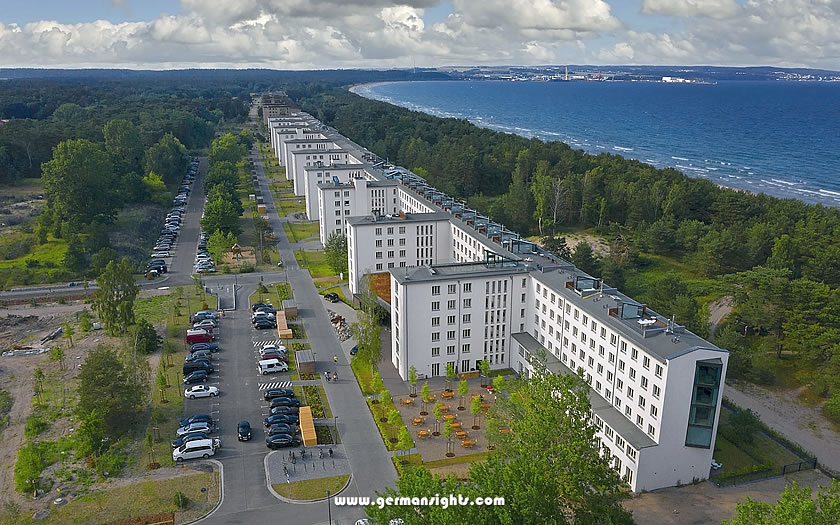
The Prora resort complex on Rügen
The island was home to the massive Prora resort complex during the Nazi era, which was intended as a holiday resort for 20,000 workers under the "Strength through Joy" program, but was never fully completed.
Rügen became part of East Germany after World War II, and its beaches were a popular holiday destination for East German citizens.
The island's tourism infrastructure has grown considerably since German reunification in 1990, while efforts have been made to preserve its natural and cultural heritage.
The iconic Jasmund National Park is Rügen's crown jewel, home to the famous chalk cliffs known as the Königsstuhl. Rising 118 metres above the Baltic Sea, these white cliffs not only provide spectacular photo opportunities, but are also home to ancient beech forests that have been recognised as a UNESCO World Heritage Site.
A well-maintained network of footpaths allows visitors to experience both the clifftop views and the unspoilt forest, while the modern visitor centre offers insights into the area's unique geology and ecology.
The island's seaside resorts embody the essence of German Baltic charm.
The most famous, Binz, showcases classic resort architecture with its elegant white villa-style hotels and legendary pier stretching out into the sea. The resort's signature bath architecture features ornate balconies, wooden verandas and decorative towers dating from the late 19th century.
Nearby, Sellin's pier and beach promenade are equally impressive examples of this distinctive architectural style, complete with the famous diving bell and restored pier restaurant.
Rügen offers several fascinating sites for those interested in history.

Cape Arkona lighthouse on Rügen
The Cape Arkona Archaeological Park contains the remains of a Slavic fortress temple and a lighthouse complex with panoramic views of the Baltic Sea.
The controversial Prora complex, which stretches 4.5 kilometres along the coast, is one of the largest architectural remnants of the Nazi era, now partly converted into apartments, museums and cultural centres.
Nature lovers will enjoy the diverse landscapes of Rügen.
The Vorpommersche Boddenlandschaft National Park ("Western Pomerania Lagoon Area National Park") includes extensive reed beds, coastal lakes and peninsulas perfect for birdwatching.
The car-free island of Hiddensee, accessible by ferry from Schaprode, is a peaceful retreat where bicycles and horse-drawn carriages are still the main means of transport.
The Southeast Rügen Biosphere Reserve offers a harmonious blend of cultivated and natural landscapes, with excellent cycle routes linking traditional fishing villages and secluded beaches.
Most of the towns and villages on Rügen island have their own physical tourist information offices. The island tourist promotion board has its own website but unfortunately it is only in German (at the time of writing).
Website: www.ruegen.de